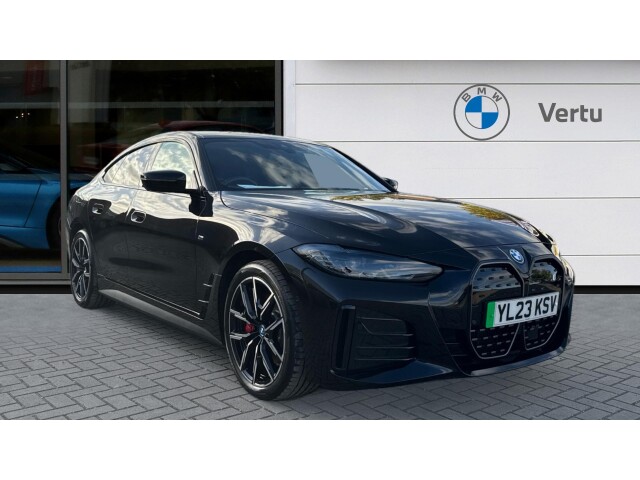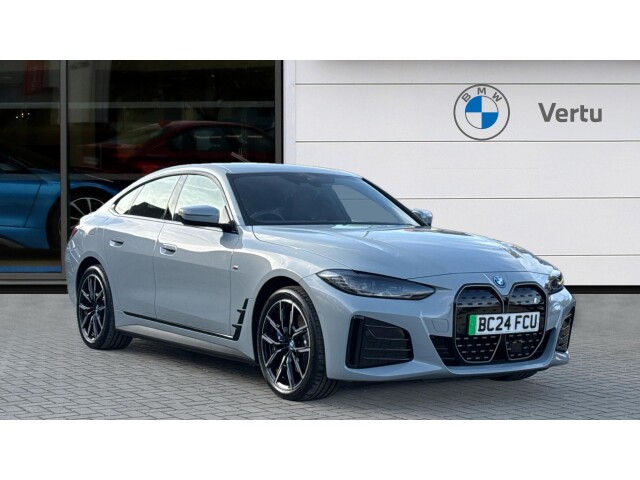Used BMW i4 for sale: everything you need to know
BMW dipped its toes into the plug-in car waters with the quirky i3 hatchback and the i8 plug-in hybrid sports car, but in recent years it’s taken a deep breath and dived fully in, now offering a range of electric vehicles alongside its more familiar combustion models.
The BMW i4 is a great example of what BMW can do with electric motors rather than combustion powerplants: It’s great to drive, performs well, offers a decent range in all variants, and if you can get past BMW’s current trend for large front grilles, it even looks pretty good - especially inside.
Only its showroom pricing counts against it, with rivals like the Tesla Model 3 and Polestar 2 available for less money - but if you’re buying used, that’s less of a concern, and if you’re coming from one of BMW’s petrol or diesel models then its performance and low running costs are sure to impress.
Should you buy a BMW i4?
The short answer is yes - the BMW i4 is just as desirable as BMWs always have been, irrespective of what powers it, but it just so happens that BMW has done a fantastic job with its 3 Series sized electric car too, and it’s one of the best of its kind to drive.
We mention the 3-series, but technically the i4’s fastback shape is closer to that of the 4 Series Gran Coupe. That means you get a practical hatchback tailgate for a start (with a perfectly decent 470 litres of space - larger than the 425 litres of a Tesla Model 3 with its less practical opening, though unlike the Tesla, the BMW has no ‘frunk’ to add even more space), loads of room for front seat occupants, and pretty decent rear seat space too provided your rear passengers aren’t as tall as those in the front.
The interior is excellent though, with a similar layout to the 3- and 4-series, including BMW’s large, curved twin screen display, controlled as ever by iDrive. The driving position is sporty, the seats have plenty of adjustment, and BMW has nailed build quality in its recent models too.
It’s on the road where the i4 really scores though. You might be able to go quicker in a Tesla, but no i4 feels slow; in fact, they arguably feel quicker than the figures in the brochure suggest, while BMW’s braking regeneration settings are very effective. The handling is as sharp as decades of BMW advertising would have you believe (despite weighing in at more than two tonnes), and the ride is excellent too.
Range isn’t bad either, in the same ballpark as the best in the segment. The eDrive40 tops the table here with up to 365 miles. Only the latest version of the Tesla Model 3 goes significantly further, with a claimed 390 miles, and Tesla’s Supercharger network is one reason you might select it over the BMW too - though it’s not as good to drive. Other alternatives include the Polestar 2, as well as slightly larger sports saloons like the Audi e-Tron GT and Porsche Taycan.
A BMW i4 not for you? We've got 1000s of used cars for sale to suit all budgets and needs
What’s the best used BMW i4 model to buy?
This is one of those cases where there are no bad choices. All BMW i4s are great to drive and since they share a body style, are just as practical as each other. There’s not even a huge difference in equipment, though it’s worth keeping an eye out for used examples that might have been upgraded with some of BMW’s accessory packs, or specified in a more eyecatching colour inside and out.
If range is the be-all and end-all then the eDrive40 is the model to go for, with a quoted 365 miles - compared to 318 miles for the M50 and a more modest 299 miles for the entry-level eDrive35. For this reason, we’d suggest the eDrive40 as the best all-rounder, and you’ll probably not be disappointed by its performance either.
Used BMW i4 range and performance
- BMW i4 eDrive35: A single 286PS electric motor provides motion in the eDrive35, and it’s not short of performance. 0-62mph comes up in six seconds flat (though top speed, like many EVs, is limited, in this case to 118mph), while BMW claims a WLTP range of up to 299 miles.
- BMW i4 eDrive40: Power takes a big step up again with another single-motor model, the eDrive 40 making 340PS. It matches the 35 on top speed but is slightly quicker to accelerate, with a 5.6-second 0-62mph time. Range is quoted at 365 miles.
- BMW i4 M50: The M50 is the only i4 to get motors on both the front and rear axles, and power steps up accordingly, to 544PS. The 0-62mph time drops to 3.9 seconds and top speed climbs to 139mph, and it’s good for up to 318 miles of range.
What used BMW i4 trim levels are available?
The BMW i4 is fairly new and has only been offered in a small spectrum of trim levels. This makes finding the right used i4 relatively easy though, not least because all models are well equipped from the off, so opting for M Sport over Sport, or the range-topping M50 over the other models won’t require too much leafing through brochures and spec sheets.
- The BMW i4 Sport comes as standard with 18-inch alloy wheels (though you can actually go down to 17 inch wheels as a no cost option), fabric interior trim with gloss black details, BMW’s wide dual-screen layout, LED headlights, and a reversing camera with parking assistant.
- The BMW i4 M Sport also has 18-inch alloy wheels, and gains M Sport exterior styling, Alcantara (synthetic suede) and Sensatec (synthetic leather) trim, aluminium interior elements
- The BMW i4 M50 upgrades to 19-inch alloy wheels, full leather upholstery, a chunky M Sport steering wheel, an automatic tailgate, and Harman Kardon audio.
Used BMW i4 dimensions and boot size
The BMW i4’s dimensions are:
- Length: 4783mm
- Width: 1852mm (without mirrors), 2073mm (with mirrors)
- Height: 1448mm
The BMW i4’s boot size is:
- 470 litres
- 1290 litres with the rear seats folded (to roof)
Used BMW i4 road tax
It’s the usual electric car story with the BMW i4’s VED or ‘road tax’ - as things currently stand, you won’t pay a penny, thanks to the i4’s zero-emissions status. That makes it considerably cheaper than the equivalent combustion-engined model to tax both now and for the foreseeable future.
How much is it to insure a BMW i4?
The BMW i4 eDrive40 Sport starts in group 35 (out of 50) for insurance, and the insurance groups step slowly up from there: the same powertrain in M Sport trim is group 36. Curiously, the eDrive35 models are a little higher, starting in group 38, but things get back on track with the M50 which is more predictably in a higher group, at 43.
Read our full BMW i4 review


